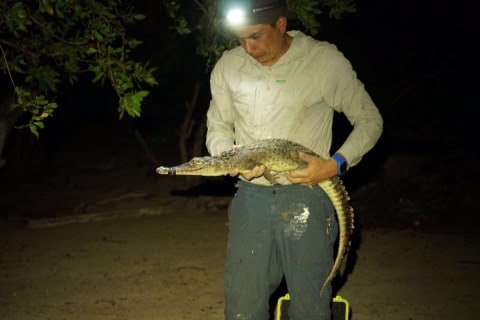The populations of both the Banco Chinchorro and Cozumel species are morphologically, genetically, and ecologically distinct, the researchers note in their paper.
Researchers with McGill University, working with scientists from El Colegio de la Frontera Sur, Chetumal, Quintana Roo, Mexico, Universidad Juárez Autónoma de Tabasco, Villahermosa, Tabasco, Mexico, Centro de Investigación y Experimentación de Alternativas Agroecológicas, Coyoacan, Mexico, Center for Research in Geospatial Information Sciences, Ciudad de México, Mexico, and the Smithsonian Tropical Research Institute in Panama, have discovered two new crocodile species off the Yucatán Peninsula in Mexico. One species was discovered on the island of Cozumel while the other was found on the Banco Chinchorro atoll.
The researchers, led by principal investigator and biology professor Hans Larsson of McGill University anaylyzed the genetic sequences of both areas in which the crocodiles were found and compared the data with crocodiles from Central America, Mexico’s Pacific Coast and across the Caribbean. The researchers said there was wide genetic divergences, which led them to determine that the two crocodiles were not variants of Crocodylus acutus but were two species new to science.
“These results were totally unexpected,” former Larsson graduate student and lead author José Avila-Cervantes said in a press release put out by McGill University. “We assumed Crocodylus acutus was a single species ranging from Baja California to Venezuela and across the Caribbean. Our study is the first to extensively explore genomic and anatomical variation in these animals.”
An interesting note in the study is the species in the Banco Chinchorro atoll tolerate the highest salinity reported of any Crocodylus species. The researchers say the hatchlings have been shown to have great survival rates in the high salinity conditions of the atoll and are also capable of surviving hurricanes.
The populations of both the Banco Chinchorro and Cozumel species are morphologically, genetically, and ecologically distinct, the researchers note in their paper.
“We suggest elevating these two insular populations of Crocodylus to new species and naming them according to their locality. These designations will have important consequences for their conservation but also for the conservation of the ecosystems and biodiversity of the Banco Chinchorro atoll and Cozumel Island.”
New Population Of Crocodylus mindorensis Crocodiles Discovered In The Philippines
The researchers note that the population of the two new species are estimated to be less than 1,000 individuals, which are limiting in numbers when considering the habitat restrictions due to loss of biodiversity in the two respective regions.
“Biodiversity is disappearing faster than we can discover what we’re losing,” Larsson said. “Most species of crocodiles are already endangered, and rapid shoreline development threatens nearly every population. Our research aimed to uncover the true diversity of crocodiles on these isolated islands.”
The complete paper describing the two new species, “Novel island species elucidate a species complex of Neotropical crocodiles” can be read on the ScienceDirect website.



